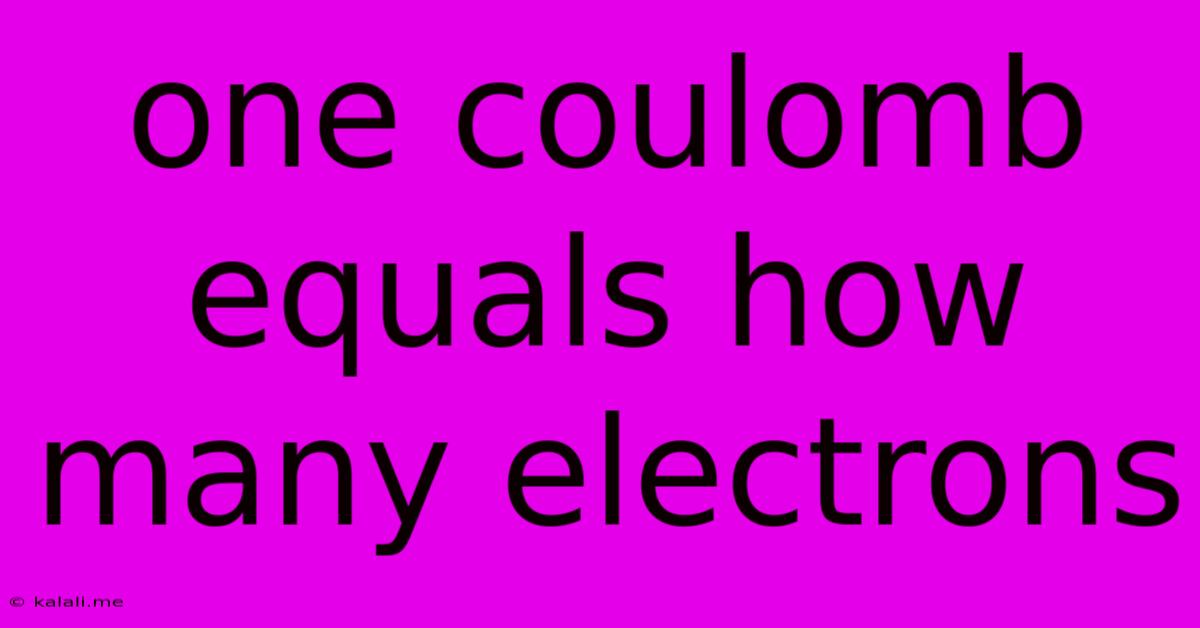One Coulomb Equals How Many Electrons
Kalali
Jun 14, 2025 · 2 min read

Table of Contents
One Coulomb: A Sea of Electrons
The coulomb (C) is the fundamental unit of electric charge in the International System of Units (SI). Understanding how many electrons constitute one coulomb is crucial for grasping the scale of electrical phenomena. This article will delve into the relationship between coulombs and electrons, exploring the underlying physics and providing a clear answer to the question: one coulomb equals how many electrons?
The answer lies in the elementary charge, the fundamental unit of electric charge carried by a single proton or electron. This charge, denoted as e, has a value of approximately 1.602 x 10⁻¹⁹ coulombs. This means that one electron carries a negative charge of this magnitude, while a proton carries a positive charge of the same magnitude.
To determine the number of electrons in one coulomb, we simply divide the total charge (1 coulomb) by the charge of a single electron:
1 C / (1.602 x 10⁻¹⁹ C/electron) ≈ 6.24 x 10¹⁸ electrons
Therefore, one coulomb is equal to approximately 6.24 x 10¹⁸ electrons. This is an incredibly large number, highlighting the minuscule nature of the charge carried by a single electron. Imagine trying to count that many grains of sand!
Understanding the Implications
This seemingly simple calculation has significant implications across various fields:
- Electronics: Understanding the charge carried by electrons is essential in designing and analyzing electronic circuits. The flow of electrons, measured in amperes (coulombs per second), is the basis of electric current.
- Electromagnetism: Coulomb's Law, a fundamental law in electromagnetism, describes the force between charged particles. Knowing the charge of a single electron allows us to calculate the electrostatic forces between electrons and other charged particles.
- Atomic Physics: The elementary charge plays a central role in understanding atomic structure and behavior. The charge of the nucleus and the electrons determines the overall charge of an atom and its interactions with other atoms.
- Material Science: The flow and behavior of electrons within materials are key to understanding their electrical conductivity and other properties. Semiconductors, for instance, rely on manipulating the flow of electrons to create electronic components.
Beyond the Calculation: A Deeper Dive
While the calculation itself is straightforward, understanding the context is crucial. The value of the elementary charge (e) has been determined through meticulous experimentation over many years. It's a fundamental constant in physics, and its accuracy is constantly being refined.
Furthermore, the concept of a "sea" of electrons is helpful to visualize the immense number involved. A single coulomb represents a vast collection of these tiny particles, collectively creating a significant electrical charge.
In conclusion, while the answer to "one coulomb equals how many electrons?" is a simple calculation, the implications of this relationship extend far beyond the numbers themselves, influencing numerous fields of science and technology. Grasping this concept provides a solid foundation for understanding the world of electricity and its applications.
Latest Posts
Latest Posts
-
A Wave Of Frequency Of 1000 Hertz Vibrates At
Jun 15, 2025
-
What Is The Highest Mountain Peak In Asia
Jun 15, 2025
-
The Velocity Of Light In Vacuum Is
Jun 15, 2025
-
A Solution In Which The Solvent Is Water
Jun 15, 2025
-
A Word On A Web Page That When Clicked
Jun 15, 2025
Related Post
Thank you for visiting our website which covers about One Coulomb Equals How Many Electrons . We hope the information provided has been useful to you. Feel free to contact us if you have any questions or need further assistance. See you next time and don't miss to bookmark.